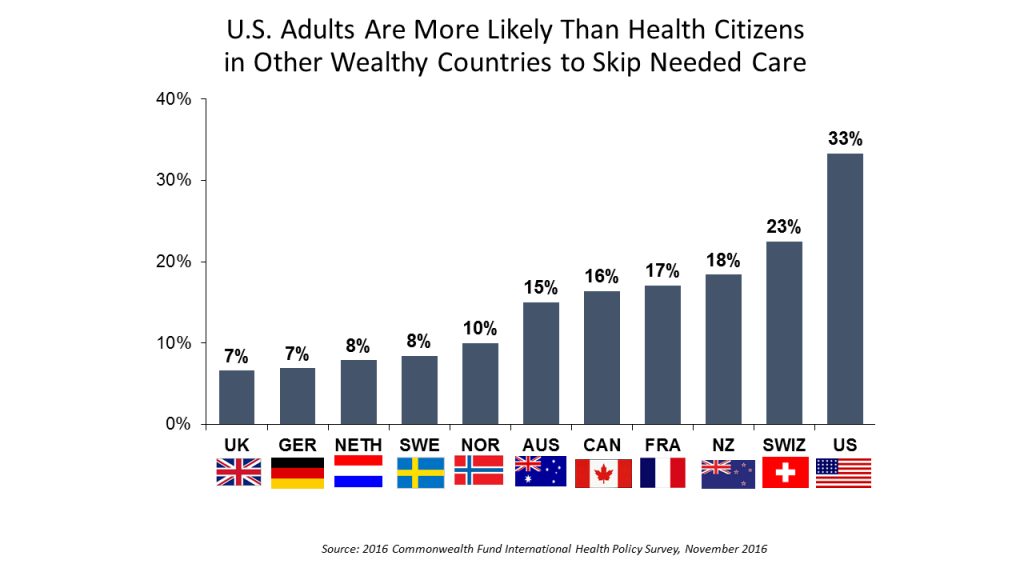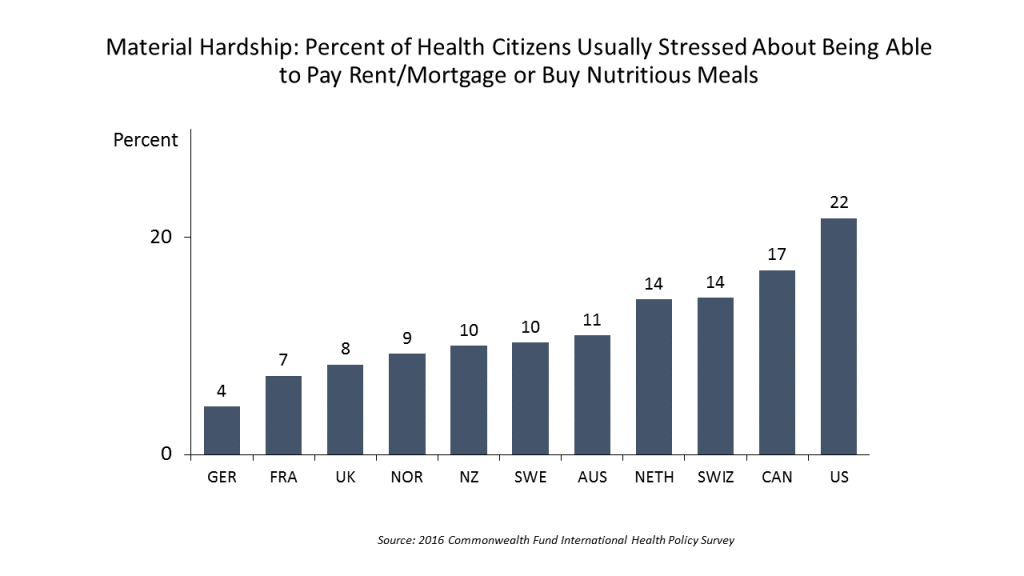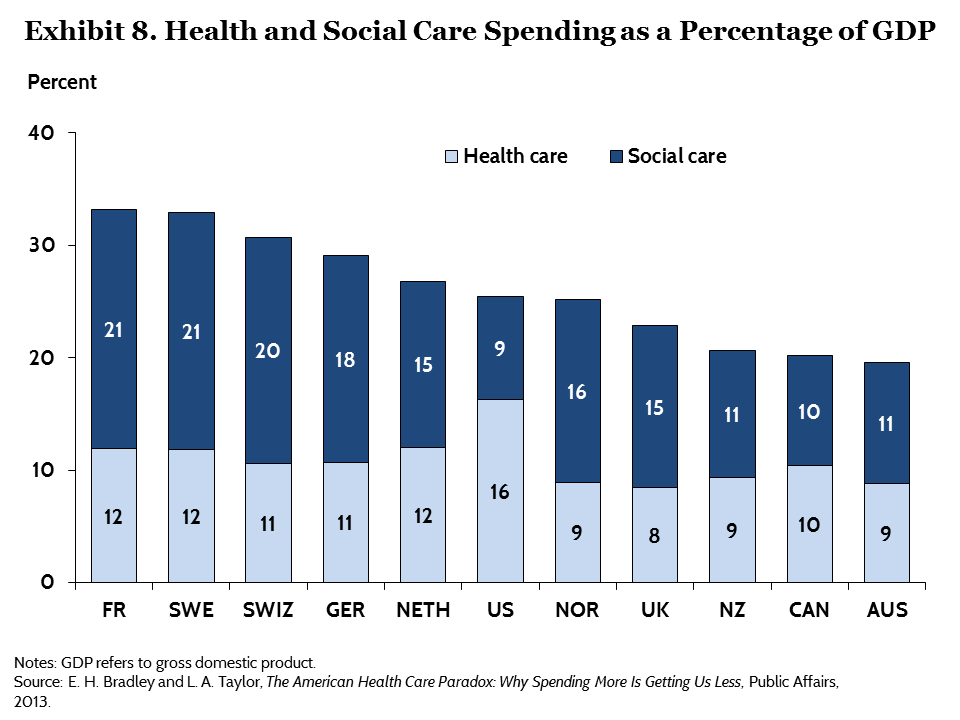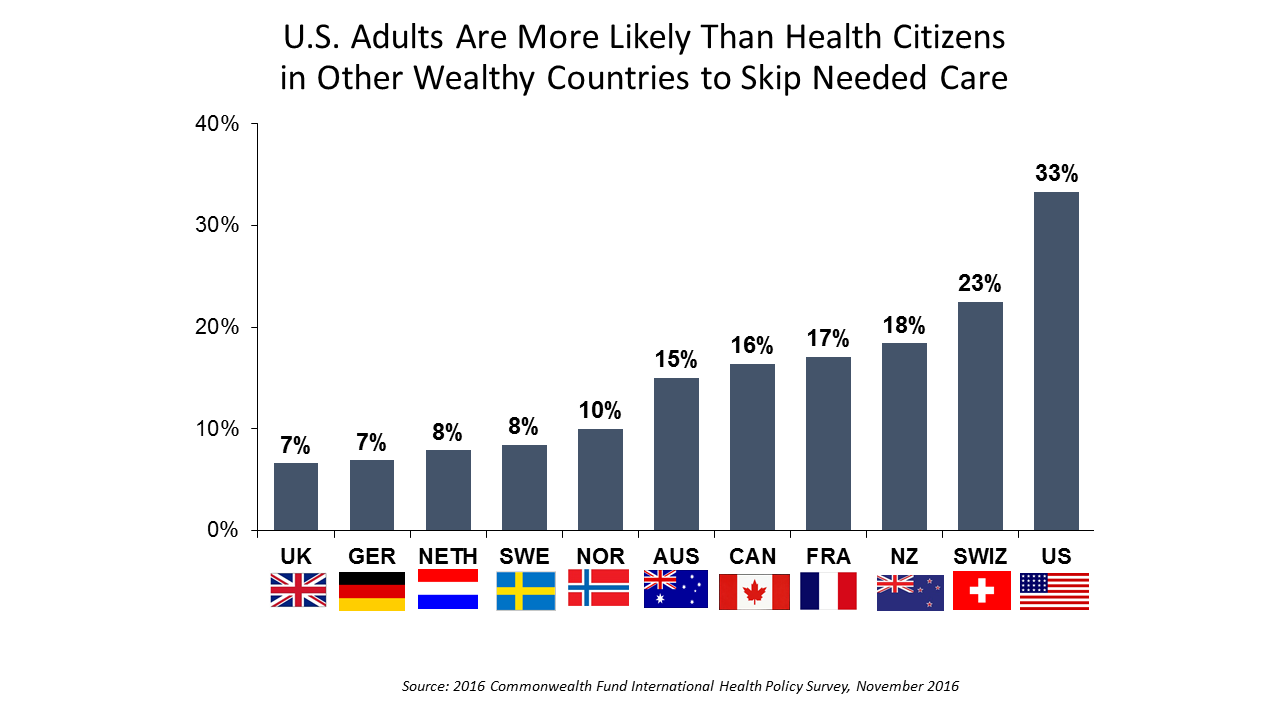 People in the U.S. are much more likely to go without health care they need compared with health citizens in 10 other wealthy countries, according to the Commonwealth Fund’s 2016 international survey. One-third of Americans did not seek care due to costs, including going without recommended care, failing to fill a prescription drug, and/or not seeing a doctor when sick. While this self-rationing proportion of Americans dropped from 37% in 2013, the U.S. still ranks #1 in foregoing necessary healthcare due to cost.
People in the U.S. are much more likely to go without health care they need compared with health citizens in 10 other wealthy countries, according to the Commonwealth Fund’s 2016 international survey. One-third of Americans did not seek care due to costs, including going without recommended care, failing to fill a prescription drug, and/or not seeing a doctor when sick. While this self-rationing proportion of Americans dropped from 37% in 2013, the U.S. still ranks #1 in foregoing necessary healthcare due to cost.
“In comparison to adults in the other 10 countries, adult sin the U.S. are sicker and more economically disadvantaged. the resulting challenge to the U.S. health system is compounded by higher health care costs, greater income disparities, and relatively low levels of spending on social services.”
For U.S. adults who did seek health care, one-half experienced health care access challenges on weekends and evenings without going to the emergency department.
 Look at the second chart, titled “Material Hardship.” This illustrates the social determinants of health aspects: that 1 in 5 U.S. adults has trouble paying the rent or mortgage, or affording nutritious food. Fewer health citizens in other wealthy nations are challenged in this way: Canada is second in line to the U.S., with 17% of Canadians stressed about paying for housing or healthy food.
Look at the second chart, titled “Material Hardship.” This illustrates the social determinants of health aspects: that 1 in 5 U.S. adults has trouble paying the rent or mortgage, or affording nutritious food. Fewer health citizens in other wealthy nations are challenged in this way: Canada is second in line to the U.S., with 17% of Canadians stressed about paying for housing or healthy food.
The Commonwealth Fund has conducted this survey for many years; this 2016 poll was conducted in each of the 11 countries among 26,863 adults via phone between March and June 2016.
Health Populi’s Hot Points: The Fund found that adults in the U.S. were the most likely to report having multiple chronic conditions, and be in poor health. One in four U.S. adults has multiple chronic conditions overall; 41% of low-income adults suffer from multiple chronic conditions. The simple truth in America: being a person with low-income directly relates to being sicker.
 “Previous surveys have shown that [compared to other industrialized nations] the U.S. has far too many people who can’t afford the care they need, even when they have health insurance,” Robin Osborn of The Commonwealth Fund said in the report’s press release. Even with the implementation of the Affordable Care Act, there remains a lack of support for low-income patients in the U.S.: while overall 33% of U.S. adults skipped healthcare due to cost, the percentage is 43% among low-income adults, by far the highest rate of self-rationing in the developed world.
“Previous surveys have shown that [compared to other industrialized nations] the U.S. has far too many people who can’t afford the care they need, even when they have health insurance,” Robin Osborn of The Commonwealth Fund said in the report’s press release. Even with the implementation of the Affordable Care Act, there remains a lack of support for low-income patients in the U.S.: while overall 33% of U.S. adults skipped healthcare due to cost, the percentage is 43% among low-income adults, by far the highest rate of self-rationing in the developed world.
The third chart illustrates what the 11 comparison countries spend on health care versus social care in the context of overall gross domestic product (GDP). Note that relatively low percentage of spending allocated to social care in the U.S.: 9%, compared with 16% of GDP devoted to health care. This is nearly inverse compared with other developed countries, except for Canada which split health and social care equally at 10% apiece in 2013.
It’s the social determinants of health that determine so much of public health status: education, good jobs, nutritious food, safe neighborhoods, financial wellness. The full Commonwealth Fund study published in Health Affairs concludes that improving the performance on the U,S, healthcare system will require a sustained commitment over the next decades, as well as, “having a national conversation on how to get the balance right between health and social care spending.”
As a new administration takes its place in Washington, DC, they would be wise to consider the role of social care in re-imagining health reform.
For more on social determinants of health in America, see Health Populi’s post, Social Determinants Impact Health More Than Health Care.





 Interviewed live on BNN Bloomberg (Canada) on the market for GLP-1 drugs for weight loss and their impact on both the health care system and consumer goods and services -- notably, food, nutrition, retail health, gyms, and other sectors.
Interviewed live on BNN Bloomberg (Canada) on the market for GLP-1 drugs for weight loss and their impact on both the health care system and consumer goods and services -- notably, food, nutrition, retail health, gyms, and other sectors. Thank you, Feedspot, for
Thank you, Feedspot, for  As you may know, I have been splitting work- and living-time between the U.S. and the E.U., most recently living in and working from Brussels. In the month of September 2024, I'll be splitting time between London and other parts of the U.K., and Italy where I'll be working with clients on consumer health, self-care and home care focused on food-as-medicine, digital health, business and scenario planning for the future...
As you may know, I have been splitting work- and living-time between the U.S. and the E.U., most recently living in and working from Brussels. In the month of September 2024, I'll be splitting time between London and other parts of the U.K., and Italy where I'll be working with clients on consumer health, self-care and home care focused on food-as-medicine, digital health, business and scenario planning for the future...